
A geyser is a spring with an intermittent discharge of water ejected turbulently and accompanied by steam. The formation of geysers is fairly rare, and is caused by particular hydrogeological conditions that exist only in a few places on Earth.

A hot spring, hydrothermal spring, or geothermal spring is a spring produced by the emergence of geothermally heated groundwater onto the surface of the Earth. The groundwater is heated either by shallow bodies of magma or by circulation through faults to hot rock deep in the Earth's crust.
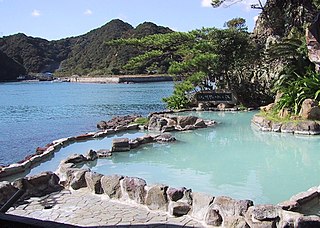
In Japan, onsen are hot springs and the bathing facilities and traditional inns around them. There are approximately 25,000 hot spring sources throughout Japan, and approximately 3,000 onsen establishments use naturally hot water from these geothermally heated springs.
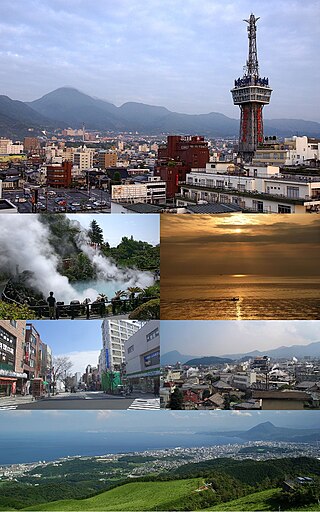
Beppu is a city in Ōita Prefecture on the island of Kyushu, Japan. As of November 30, 2023, the city had a population of 113,045 in 62702 households, and a population density of 900 persons per km2. The total area of the city is 125.34 km2 (48.39 sq mi). Beppu is famous for its hot springs.
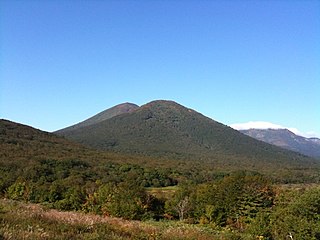
The Hakkōda Mountains are an active volcanic complex in south-central Aomori Prefecture, Japan, in Towada-Hachimantai National Park. Often called Mount Hakkōda or simply Hakkōda (八甲田), the mountains are collectively listed as one of the 100 Famous Japanese Mountains. Its highest peak, Mount Ōdake, lies 21.3 kilometers (13.2 mi) southeast of central Aomori and 28 kilometers (17 mi) west of central Towada and has an elevation of 1,585 meters (5,200 ft). The Hakkōda Mountains are a part Ōu Mountains which make up part of the Northeastern Japan Arc, a segment of the Pacific Ring of Fire. The volcanic complex consists of fourteen stratovolcanoes and lava domes arranged into two volcanic groups. The Northern Hakkōda Volcanic Group emerges from the rim of an 8-kilometer-wide (5.0 mi) caldera that dates back to the Pleistocene. The Southern Hakkōda Volcanic Group predates the caldera.
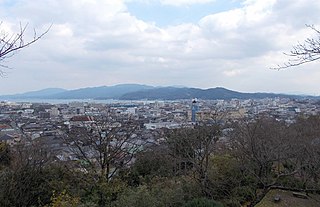
Amakusa is a city located in Kumamoto Prefecture, Japan.

Tamagawa Hot Spring is a hot spring located in the city of Semboku, Akita in northern Japan.
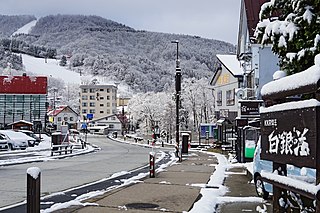
Zaō Onsen (蔵王温泉) is a famous hot spring area on Mount Zaō in the northern part of Honshū, the main island of Japan.
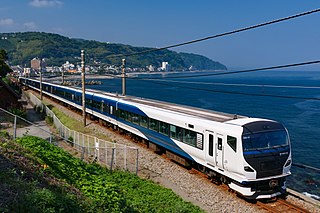
Odoriko is a limited express train service in Japan operated by the East Japan Railway Company, Central Japan Railway Company, Izukyu Corporation, and Izuhakone Railway, which runs between Tokyo and Izukyū-Shimoda or Shuzenji in Shizuoka Prefecture.

The 251 series was a DC electric multiple unit (EMU) train type operated by East Japan Railway Company on Tokaido Main Line Super View Odoriko limited express services in Japan between April 1990 and March 2020.

Mount Hachimantai is the highest peak of a group of stratovolcanos distributed around the Hachimantai plateau in the Ōu Mountains in northern Honshū, Japan. This volcanic plateau is part of the Nasu Volcanic Zone and straddles the border between the Iwate Prefecture and Akita Prefecture. The volcano is listed as one of the 100 Famous Japanese Mountains, and forms part of the Towada-Hachimantai National Park.

Nishiyama Onsen Keiunkan is an onsen in Yamanashi Prefecture. Founded in 705 by Fujiwara Mahito, it is a prime example of shinise and perhaps the oldest independent company in operation following the acquisition of construction company Kongō Gumi in 2006.

Beppu Onsen (別府温泉) is an extensive hot spring system in the city of Beppu, Ōita, Japan. There are eight distinct major thermal spring zones called "Beppu Hatto"(別府八湯).

The hot spring system Hells of Beppu is a nationally designated "Place of Scenic Beauty" in the onsen town of Beppu, Ōita, Japan. The "hells," or "jigoku" (地獄) in Japanese, are for viewing rather than bathing.
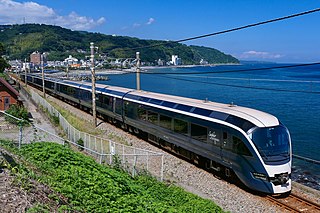
The E261 series is an electric multiple unit (EMU) train type operated by East Japan Railway Company in Japan on Saphir Odoriko limited express services between Tokyo and Izukyū-Shimoda. It was designed to replace the older 251 series trains that were used on Super View Odoriko limited express services from April 28, 1990, until March 13, 2020.
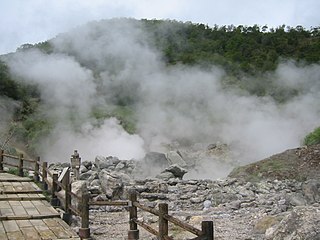
Unzen Onsen is a geothermally heated volcanic hot spring field in the Unzen Mountains in Nagasaki prefecture in Japan. It was known of for many years, and in the 1910s was developed into a hot spring community because of its many springs. In 1934 the area was designated as the first national park in Japan.
Hakone Onsen, or Hakone Hot Springs, is a general term for numerous thermal spas located in the town of Hakone, Ashigarashimo District, Kanagawa Prefecture, Japan, an area formerly known as Sagami Province. Situated about 90 kilometres (56 mi) southwest of Tokyo and 60 kilometres (37 mi) east-southeast of Mt. Fuji, it is one of the most popular hot spring resorts in central Japan. At least twenty hot spring spring resorts exist around Mt. Hakone, an area that is designated as part of the Fuji Hakone Izu National Park.

Yunomine Onsen is a hot spring system and resort town in Tanabe, near Hongu Town in southern Wakayama Prefecture, Japan. The Tsuboyu bath is located there, a UNESCO World Heritage site.


















